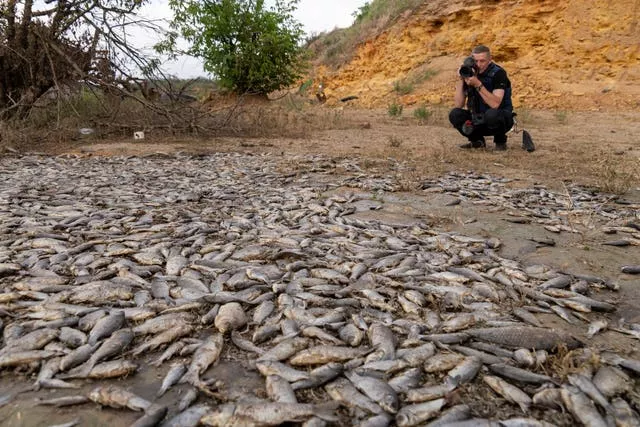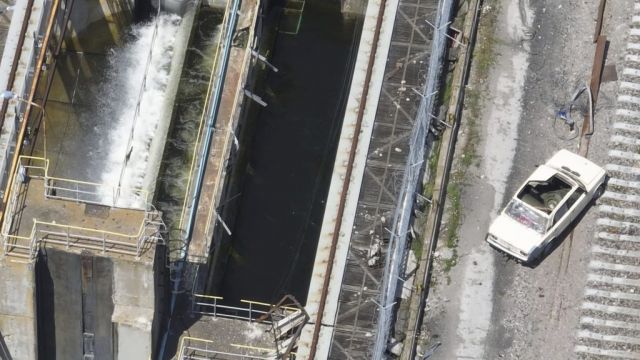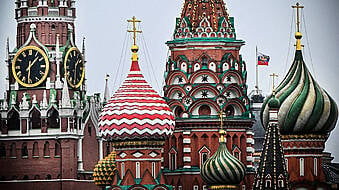The United Nations has rebuked Moscow for allegedly denying its aid workers access to Russian-occupied areas affected by the recent Kakhova dam collapse in southern Ukraine.
The subsequent flooding stranded residents, threatened power supplies and caused an environmental calamity as the war approaches the 16-month mark.
The Kremlin’s spokesman later said UN aid workers who want to visit areas ravaged by the collapse in southern Ukraine cannot go there because the fighting makes it unsafe.

The UN humanitarian coordinator for Ukraine, Denise Brown, said the organisation has engaged with Moscow and Kyiv, each of which occupies parts of the southern Kherson region where the dam and reservoir are located, to address the “devastating destruction” caused by the breach.
The Russian government “has so far declined our request to access the areas under its temporary military control”, Ms Brown said.
“We urge the Russian authorities to act in accordance with their obligations under international humanitarian law,” her statement added.
Latest Defence Intelligence update on the situation in Ukraine - 19 June 2023.
Find out more about Defence Intelligence's use of language: https://t.co/vwV6Pe2K1I
🇺🇦 #StandWithUkraine 🇺🇦 pic.twitter.com/tlnuet4ZoWAdvertisement— Ministry of Defence 🇬🇧 (@DefenceHQ) June 19, 2023
Kremlin spokesman Dmitry Peskov did not explicitly admit that Russia had blocked UN access, but told a conference call with reporters that Ukrainian attacks made any such visit too risky.
“There has been constant shelling, constant provocations, civilian facilities and the civilian population have come under fire, people have died, so it’s really difficult to ensure their security,” Mr Peskov said.
His comments came amid varying accounts by survivors of the quality of assistance that Russia is providing in areas it controls. The dam lies on the Dnieper River, which forms the front line between Russian and Ukrainian forces on the eastern and western banks, respectively.

Many evacuees and residents accuse Russian authorities of doing little or nothing to help. Some civilians said that evacuees were sometimes forced to present Russian passports if they wanted to leave.
On the Ukrainian side, rescuers are braving Russian snipers as they rush to ferry Ukrainians out of Russia-occupied flood zones.
Exclusive drone photos and information obtained by The Associated Press indicate Russia had the means, motive and opportunity to blow up the dam, which was under Russian control, earlier this month.
The explosion occurred as Ukraine mustered for a counter-offensive. Kyiv’s forces have intensified attacks along the 600-mile front line recently.

The dam lies on the Dnieper River, which forms the front line between Russian and Ukrainian forces on the eastern and western banks, respectively.
Some analysts saw the dam breach as a Russian effort to thwart Ukraine’s counter-offensive in the Kherson region.
The UK’s Ministry of Defence said Russia has recently redeployed several thousand troops from the banks of the Dnieper to buttress its positions in the Zaporizhzhia and Bakhmut sectors, which have reportedly seen heavy fighting.
The move “likely reflects Russia’s perception that a major Ukrainian attack across the Dnieper is now less likely” following the dam’s collapse, the MoD said in a tweet.
"The Government of the Russian Federation has so far declined our request to access the areas under its temporary military control."
Denise Brown added that engagements continue to ensure we can reach all people who need assistance.
Her statement: https://t.co/VVTUD234xB pic.twitter.com/CA2jGMNJ0m— OCHA Ukraine (@OCHA_Ukraine) June 18, 2023
Ukrainian deputy defence minister Hanna Maliar said Kyiv’s forces have liberated a total of eight settlements in the course of two weeks on the Berdyansk and Melitopol axes of their counter-offensive in the country’s south-east.
Kyiv’s forces have advanced up to four miles into territory previously held by Russia, she claimed.
It was not possible to independently verify battlefield claims by either side.
Russia attacked south and south-east Ukraine overnight with cruise missiles and self-exploding drones, Ukraine’s Air Force reported.
Four Kalibr missiles and four Iranian-made Shahed drones were shot down, it said.
According to regional officials, the southern province of Odesa and the south-eastern Dnipropetrovsk region were targeted by the attack. No casualties or damage were immediately reported.







